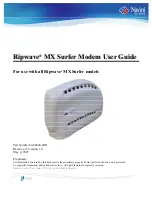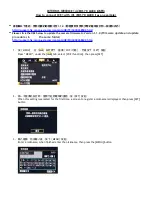
Navini Networks, Inc.
Ripwave MX Surfer Modem User Guide
15
English_Surfer_User_Guide_2007-05-04_40-00444-00Ra(6.X)
Signal Strength & Signal
Quality Bars, continued
How to Increase
the Signal Strength
& Quality
History Graphs
In particular, the Signal Strength bar area graphically represents the
strength of the synchronization signal your Modem is receiving
from the Base Station. The strength of the signal is represented by
a group of colored bars. The greater the number of bars, the
stronger the signal is. The color of the bars also gives an indication
of the strength of the signal:
►
Green indicates an excellent signal.
►
Orange indicates a good signal.
►
Red indicates a weak signal.
The Signal Quality bars graphically represent the Signal-to-Noise
Ratio (SNR) received by your Modem. SNR is measured in
decibels. Like Signal Strength, the quality of the signal is
represented by the number of bars and their color:
►
Green indicates an excellent signal.
►
Orange indicates a good signal.
►
Red indicates a weak signal.
To increase the strength and quality of the signal, change the
location of your Modem. Try moving it closer to a window, to a
higher location, away from other wireless devices (microwave
ovens, cordless phones), and away from metal objects (shelves, file
cabinets). As you reposition the Modem, watch the Signal Strength
and Signal Quality bars on the NavDiag screen. Place your Modem
in the location where you receive the most green signal strength
and quality bars.
The History graphs plot the change in signal strength and signal
quality over time. The graphs cover the last minute of time and are
updated every second. You read the graphs from right to left. The
right side of the graph represents the most recent status of your
Modem’s signal history.
















































